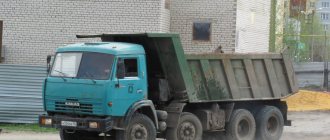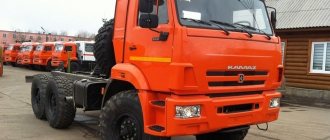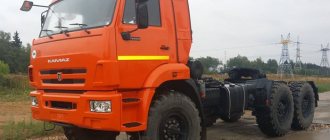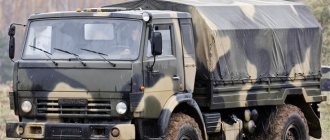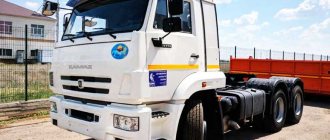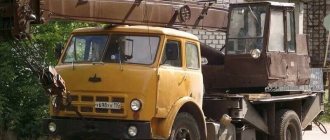Kamaz truck tractor
This shows the fifth wheel load in tons.
| KAMAZ-53504-50 | 12,3 |
| KAMAZ-5490-68 (T5) | 10,55 |
| KAMAZ-5490-87 (S5) | 10,6/11,1 |
| KAMAZ-54901-92 | 10,43 |
| Gas-diesel KAMAZ-5490 NEO (CNG) | 10,76 |
| KAMAZ-5490 NEO | 10,62 |
| Gas vehicles KAMAZ-5490 NEO 2 | 10,4/10,7 |
| KAMAZ-65116-48 (A5) | 15,5 |
| KAMAZ-65206-68 (T5) | 16,75 |
| KAMAZ-65206-87 (S5) | 16,75 |
| KAMAZ-65209-87 (S5) | 17,16 |
| KAMAZ-65221-53 | 17 |
| KAMAZ-65225-53 | 22 |
| KAMAZ-65806-68 (T5) | 23,22 |
Vehicle plate
The vehicle manufacturer's plate is installed in the right door opening.
The plate contains:
- name of the manufacturer;
- identification number, including: XTC - manufacturer code;
- a - conventional car model code, consisting of six characters;
- b — year of manufacture code (1 character);
- с — serial production number of the vehicle (7 characters);
If the technically permissible maximum mass exceeds the corresponding permissible maximum mass, the mass values are indicated in two columns.
Technically permissible maximum weights:
- m* — technically permissible maximum weight of the vehicle;
- m1* — technically permissible maximum weight of a road train (for tractors);
- P1* - technically permissible maximum weight on the front axle;
- P2* - technically permissible maximum weight on the second axle;
- P3* - technically permissible maximum weight on the third axle;
- P4* - technically permissible maximum weight per fourth axle.
- Permitted maximum weights:
- m is the permissible maximum weight of the vehicle;
- m1 — permissible maximum weight of the road train (for tractors);
- P1 - permitted maximum weight on the front axle;
- P2 - permitted maximum weight on the second axle;
- P3 - permitted maximum weight on the third axle;
- P4 - permitted maximum weight per fourth axle.
Kamaz dump truck
| KAMAZ-43255-69 (G5) | 7,75 |
| KAMAZ-45143-50 | 11,7 |
| KAMAZ-53605-48 (A5) | 11,7 |
| KAMAZ-65111-50 | 14 |
| KAMAZ-65111-48 (A5) | 14 |
| KAMAZ-65115-48 (A5) | 15 |
| KAMAZ-6520-001-49 (B5) ARX | 21 |
| KAMAZ-6520-21010-53 ARX | 20,9 |
| KAMAZ-6520-49 (B5) | 20 |
| KAMAZ-6520-53 | 20 |
| KAMAZ-65201-001-49 (B5) ARX | 27 |
| KAMAZ-65201-21010-53 ARX | 27 |
| KAMAZ-65201-49 (B5) | 19 |
| KAMAZ-65201-53 | 25,5 |
| KAMAZ-6522-53 | 19 |
| KAMAZ-65222-53 | 19,57 |
| KAMAZ-6580-87 (S5) | 25,45 |
| KAMAZ-65801-68 (T5) | 32,43 |
| KAMAZ-65801-68 (T5) with side unloading | 30 |
| KAMAZ-65801-T5 Dump truck-coal carrier | 31,44 |
| KAMAZ-65801-T5 Dump truck for transporting rocks | 31 |
| KAMAZ-65802-87(S5) | 24,8 |
Onboard Kamaz with a manipulator (KMU)
| KAMAZ-5325 with PALFINGER PK 13501 SLD CMU | 7,98 |
| KAMAZ-65207 with KMU Galician KMU-150 | 10,75 |
| KAMAZ-65207 with KANGLIM KS1256G-II TOP CMU | 10,4 |
| KAMAZ-65207 with CMU DONG YANG SS1956 | 10,55 |
| KAMAZ-65207 with PALFINGER PK15500A CMU | 12,8 |
| KAMAZ-65207 with PALFINGER INMAN IM 150N CMU | 12,8 |
| KAMAZ-65207 with PALFINGER PK23500A CMU | 11,8 |
| KAMAZ-65117 with KMU Galician KMU-150 | 9,8 |
| KAMAZ-65117 with KMU Galician KMU-150 | 9,5 |
| KAMAZ-65117 with KANGLIM KS1256G-II TOP CMU | 10,15 |
| KAMAZ-65117 with CMU DONG YANG SS1956 | 9,1 |
| KAMAZ-65117 with CMU DONG YANG SS1956 | 8,7 |
| KAMAZ-65117 with PALFINGER PK23500A CMU | 11,2 |
| KAMAZ-65117 with PALFINGER PK23500A CMU | 11,35 |
| KAMAZ-65117 with PALFINGER PK15500A CMU | 11,87 |
| KAMAZ-65117 with PALFINGER PK15500A CMU | 11,92 |
| KAMAZ-65115 with PALFINGER INMAN IT 150 CMU | 10,6 |
| KAMAZ-65115 with PALFINGER INMAN IT 150 CMU | 9 |
| KAMAZ-65115 with KANGLIM KS1256G-II TOP CMU | 8,7 |
| KAMAZ-65115 with KANGLIM KS1256G-II TOP CMU | 7,4 |
| KAMAZ-65115 with CMU DONG YANG SS1956 | 9,2 |
| KAMAZ-65115 with CMU DONG YANG SS1956 | 7,75 |
| KAMAZ-65115 with PALFINGER PK23500A CMU | 11,6 |
| KAMAZ-65115 with PALFINGER PK23500A CMU | 10,8 |
| KAMAZ-43118 with KMU Galician KMU-150 | 6,7 |
| KAMAZ-43118 with CMU DONG YANG SS1956 | 5,62 |
| KAMAZ-43118 with PALFINGER PK23500A CMU | 7,76 |
Table 3 ————————————————————————— Model Engine parameters ——————————————————— KamAZ type D x S, working nnom, Ne, Mkr max, mm volume, l min-1 kW(hp) H•m(kgf•m) ————————————————— ——————— 740.73-400 V-8 120 x 130 11.76 1900 294(400) 1766(180) 740.70-360 265(360) 1570(160) 740.71-320 236(320) 1373(140) 740.72-280 206(280) 1177(120) 570.40-240 V-6 120 x 120 8.14 1900 177(240) 980(100) 570.42-200 147(200) 180(80) ——————— ————————————————— Table 4 —————————————————————————— Engine model KamAZ; year of its release Parameter ———————————————————— 740.10; 7403.10; 740.11 740.50 740.60 project -240; -360; -360; 1976 1983 1996 1998 2004 2008 —————————————————————————— Resource, thousand km 180 350 450 600 800 1000 Ме max, 1570(180) N • m (kgf • m) 590(60) 785(80) — 1472(150) 1766(180) gе min, g/(kW • h) [h/(hp • h)] 224(165) 211(155) 206(152) 204(150) 204(150) 193(142) Oil consumption for waste, % of fuel consumption 0.8 0.5 0.26 0.2 0.1 efficient fuel injection process, which , as is known, reduces emissions of harmful substances and engine noise, reduces the time required to start and warm up a cold engine, and prevents the appearance of “white smoke”. The second measure is the use of four-valve cast iron cylinder heads. Thanks to it, gas exchange losses are reduced, the mechanical efficiency of the engine and the air filling ratio of its cylinders are increased; the nozzle moves to the center of the head, which, in turn, makes it possible to install a nozzle with a number of holes up to eight, improve fuel distribution throughout the combustion chamber, make more efficient use of the air in it, and make the combustion chamber itself wider. The third measure is electronic engine control based on the advance angle of fuel injection, which makes it possible to comply with exhaust gas toxicity standards without compromising the fuel efficiency of the diesel engine, reduce the emission of “white smoke” during warm-up mode during a cold start, and improve the performance of the vehicle as a whole. The fourth measure, without the implementation of which it is impossible to achieve environmental indicators that comply with Euro-4 and Euro-5 standards, is an integrated exhaust gas treatment system, which can consist of several subsystems. For example, supplying ammonia or urea to the combustion chamber; special filters, including thermal ones (with afterburning); continuous regeneration; exhaust gas recirculation. The fifth activity is the introduction of improved turbocharging systems: with regulation of charge air cooling; turbochargers with variable geometry of the turbine nozzle apparatus or an adjustable nozzle apparatus, as a result of which engine performance is improved not only at control points, but also in partial and transient modes, since with a change in the geometry of the nozzle apparatus, the throughput of the turbine changes in accordance with the engine operating mode and the energy of the exhaust gases is used more fully. The sixth activity is improvement of the cylinder block. In particular, a block cast from cast iron with vermicular graphite, which has good casting properties, thermal conductivity and higher mechanical properties than gray cast iron SCh21 traditionally used when casting blocks, thereby increasing the strength characteristics of the block by more than 60%, reducing operating noise engine by 0.1-1.5 dBA. The seventh measure is the replacement of aluminum alloy AK9ch with a hardness of at least 90 HB, used for the manufacture of cylinder heads, with aluminum alloy AK6M2 with a hardness of at least 120 HB and a tensile strength of 270-290 MPa (2700-2900 kgf/cm2), which also has same, higher heat resistance. As a result, the performance and resource of the diesel engine increases from 500 thousand to 800 thousand km of vehicle mileage. In addition, for Euro-4 engines with a power of more than 265 kW (360 hp), it is planned to use four-valve cylinder heads made of ChVG-35 cast iron, the tensile strength of which is 360-450 MPa, or 3600-4500 kgf/ cm2. The eighth event is a non-heat-treatable cylinder liner for engines of Euro-2 level and higher, made from special alloy cast iron, which differs from cast iron subjected to volumetric hardening by the presence in its chemical composition of elements such as molybdenum, phosphorus, boron. Additional alloying made it possible to obtain a structure and hardness of the material that provides exceptionally high wear and tear resistance, and to increase the service life of the liners to 800 thousand kilometers. The ninth event is new piston ring designs. For example, the upper compression ring now has the shape of a double-sided trapezoid with an angle of 6°, its working surface with a chrome-ceramic wear-resistant coating is made in the form of an offset barrel; the second compression one is rectangular, scraper type, subjected to nitriding; the oil scraper ring has a height of 4 mm, and the radial thickness is reduced by 0.25 mm; the working belts are chrome-plated. The tenth event is the transition to a composite piston design for Euro-4 engines. The head of this piston is made of heat-resistant steel, the skirt is made of aluminum alloy. They are connected to each other by a piston pin. The head part has a gallery for organized oil movement, which increases the efficiency of its cooling, and the upper compression ring is located at a distance of 10 mm from the piston bottom. Oil for cooling the piston (flow rate - 6-8 l/min) is supplied by a nozzle installed in the cylinder block. As a result of the implementation of the listed design solutions for the cylinder-piston group, the quality of running-in has improved, friction losses have decreased, wear resistance has increased and the service life of the cylinder-piston group has been ensured for at least 800 thousand kilometers with oil consumption for waste not exceeding 0.1% of fuel consumption. Another area of KamAZ’s work is gas engines. In 2003, the first stage of development work on them was completed, acceptance was carried out Table 5 ————————————————————————— Model Engine parameters ——— —————————————————— KamAZ type D x S, working nnom, Ne, Mkr max, Application- mm volume, l min-1 kW (hp) H• m(kgf•m) capacity —————————————————————————— 820.52-260 1079(110) Cars 820.53-240 V-8 120 x 130 11 ,76 2200 191(260) 932(95) Buses —————————————————————————— test of the KamAZ-820.52-250 transport gas engine (Fig. 3), equipped with an electronic control system. Its main parameters, as well as the parameters of the bus modification (KAMAZ-820.52-240) are given in table. 5. Both engines are based on the turbocharged KamAZ-740.50-360 diesel engine, with intermediate cooling of the charge air, the following changes have been introduced into the design: the pistons have a cylindrical combustion chamber with a compression ratio of 12; cylinder heads have been modified to accommodate the installation of spark plugs and gas electromagnetic dispensers; a gas filter, a gas supply system to the dispensers, and a non-contact ignition system were used; a throttle valve with an electric drive and its position sensor and an electronic control unit (M20 controller). In 2005, development work on both gas engines was completed. Currently, operational tests of buses and cars equipped with them are underway. And they are doing well. For example, NefAZ buses undergoing testing at Uraltransgaz LLC by 2005 had an average mileage of 40 thousand km. And, as measurements have shown, they fully meet the requirements of Euro-2 standards.
Kamaz chassis
The permissible weight of the superstructure with cargo is indicated here in tons.
| Chassis KAMAZ-4308-69 (G5) | 8 |
| Chassis KAMAZ-43118-50 | 12,68 |
| Chassis KAMAZ-43253-69 (G5) | 9,69 |
| Chassis KAMAZ-43255-69 (G5) | 9,9 |
| Chassis KAMAZ-43502-66 (D5) | 5,3 |
| Chassis KAMAZ-5308-48 (A5) | 9,29 |
| Chassis KAMAZ-5325-1001-69 (G5) | 12,55 |
| Chassis KAMAZ-5325-1002-69 (G5) | 12,51 |
| Chassis KAMAZ-5350-66 (D5) | 8,6 |
| Chassis KAMAZ-53605-48 (A5) | 13,95 |
| Chassis KAMAZ-63501-52 | 16 |
| Chassis KAMAZ-65111-50 | 16,92 |
| Chassis KAMAZ-65115-48 (A5) | 17,92 |
| Chassis KAMAZ-65117-48 (A5) | 16 |
| Chassis KAMAZ-6520-53 | 23,6 |
| Chassis KAMAZ-65201-53 | 30 |
| Chassis KAMAZ-65221-53 | 22,9 |
| Chassis KAMAZ-65222-53 | 23,1 |
| Chassis KAMAZ-65224-53 | 19 |
| Chassis KAMAZ-6540-48 (A5) | 22 |
| Chassis KAMAZ-6560-53 | 23,52 |
| Chassis KAMAZ-6580-3051-68 (T5) | 29,6 |
A few facts about the manufacturer
The founding date of the Kama Automobile Plant is considered to be August 14, 1969, when the Decree “On the construction of a complex of automobile plants in Naberezhnye Chelny of the Tatar Autonomous Soviet Socialist Republic” was signed. And the first KamAZ truck rolled off the production line of the enterprise on February 16, 1976.
In the mid-2000s, the company began cooperation with the German company Daimler AG, which grew first into the provision of facilities for the assembly of German trucks, and then a licensing agreement for the production of cabins for cars, incl. KamAZ and Mercedes Axor truck tractors. On Russian cars these cabins were designated K5.
KAMAZ products are supplied not only within the country. It is in demand in countries near and far abroad. The production volume is over 30 thousand cars per year, for the sale of which a network of dealers is used.


